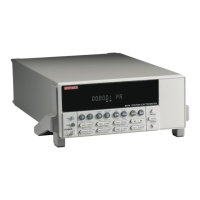12-10 Remote Operation
Front panel GPIB operation
The following paragraphs describe aspects of the front panel that are part of GPIB operation,
including messages, status indicators, and the LOCAL key.
Error and status messages
See Appendix B for a list of error and status messages associated with IEEE-488 program-
ming. The instrument can be programmed to generate an SRQ, and command queries can be per-
formed to check for specific error conditions.
GPIB status indicators
The REM (remote), TALK (talk), LSTN (listen), and SRQ (service request) annunciators
show the GPIB bus status. Each of these indicators is described below.
• REM — This indicator shows when the instrument is in the remote state. REM does not
necessarily indicate the state of the REM line, as the instrument must be addressed to
listen with REM true before the REM indicator turns on. When the instrument is in
remote, all front panel keys, except for the LOCAL key, are locked out. When REM is
turned off, the instrument is in the local state, and front panel operation is restored.
•TALK — This indicator is on when the instrument is in the talker active state. Place the
unit in the talk state by addressing it to talk with the correct MTA (My Talk Address)
command. TALK is off when the unit is in the talker idle state. Place the unit in the talker
idle state by sending a UNT (Untalk) command, addressing it to listen, or sending the
IFC (Interface Clear) command.
• LSTN — This indicator is on when Model 6514 is in the listener active state, which is
activated by addressing the instrument to listen with the correct MLA (My Listen
Address) command. LSTN is off when the unit is in the listener idle state. Place the unit
in the listener idle state by sending UNL (Unlisten), addressing it to talk, or sending the
IFC (Interface Clear) command over the bus.
• SRQ — You can program the instrument to generate a service request (SRQ) when one
or more errors or conditions occur. When this indicator is on, a service request has been
generated. This indicator stays on until the serial poll byte is read or all the conditions
that caused SRQ have ceased to exist.
LOCAL key
The LOCAL key cancels the remote state and restores local operation of the instrument.
Pressing the LOCAL key also turns off the REM indicator and returns the display to normal if
a user-defined message was displayed.
If the LLO (Local Lockout) command is in effect, the LOCAL key is also inoperative.

